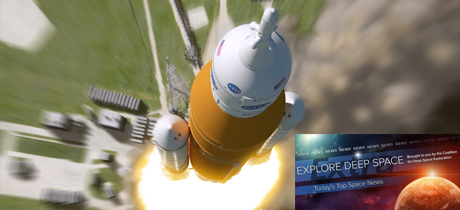In Today’s Deep Space Extra… Executives of Boeing and Lockheed Martin see possible cost reductions for NASA’s Space Launch System heavy lift rocket and Orion crew capsule as deep space missions get underway and production grows.
Human Deep Space Exploration
Before reaching the launch pad, rocket’s price may be returning to Earth
Wall Street Journal (4/9): As they approach Exploration Mission-1 (EM-1), the first joint test flight of NASA’s Orion crew capsule and Space Launch System rocket, contractors Lockheed Martin and Boeing are addressing how they might sharply reduce costs of later versions of the two major spacecraft components intended to support future human deep space exploration. EM-1, which will send Orion unpiloted around the moon and back in late 2018, may launch instead with astronauts. NASA is assessing the prospects of including a crew and the impact to mission timing. The agency faces flat or declining annual budgets in the next few years. Estimated SLS launch costs of $1 billion could perhaps be cut by half with greater automation during production, according to the deliberations.
Anniversary of Yuri Gagarin’s historic spaceflight marked in Russia and worldwide
TASS of Russia (4/12): Wednesday marks “Cosmonautics Day” in Russia, the 56th anniversary of the first human spaceflight. Former Soviet cosmonaut Yuri Gagarin carried out a dramatic single orbit of the Earth on April 12, 1961. The flight would trigger a superpower race to the moon, won by the U.S. as NASA’s Apollo 11 crew touched down on the lunar surface on July 20, 1969. Also celebrated around the world as Yuri’s Night and the International Day of Human Space Flight, Gagarin’s achievement now inspires future human space exploration.
Space Science
Metal detected in Mars’ atmosphere
Space News (4/11): Data from NASA’s Maven mission, which has been orbiting Mars since September 2014, reveals the presence of charged atoms of iron, magnesium and sodium at high altitudes. Their source is interplanetary dust, according to findings published in the journal Geophysical Research Letters. The discovery is helping scientists to understand the dynamics of the Martian atmosphere.
Scientists fear climate data gap as Trump aims at satellites
New York Times (4/10): President Trump’s proposed 2018 budget for NASA has some scientists concerned there will be losses of important climate science data, with a proposal to eliminate four climate science missions to achieve a savings of $103 million. Those missions track clouds, carbon dioxide and airborne particulates.
Scientists have found a second, unexpected great spot on Jupiter
Ars Technica (4/11): Astronomers have identified a second remarkably sized spot on giant Jupiter. For centuries they’ve studied the famous giant red spot. The source of the second smaller, cooler landmark spot is unclear. Experts hope NASA’s Juno mission, currently in polar orbit around Jupiter, will help to solve the mystery.
Low Earth Orbit
U.S. military orders two more surveillance satellites to roam geosynchronous orbit
Spaceflightnow.com (4/10): The U.S. Air Force has asked Orbital ATK to begin the development of two more satellites designed for space surveillance and tracking of objects in the crowded geosynchronous orbit realm.
Commercial crew flight assignments could come this summer
Space News (4/11): NASA’s Commercial Crew Program is overseeing the development of two spacecraft capable of transporting astronauts to and from the International Space Station, Boeing’s CST-100 and SpaceX’s crewed Dragon. NASA may be close to assigning astronauts to test flights planned for 2018.
Two launches from Russia’s new Vostochny space center due this year
TASS of Russia (4/12): Russia’s large new Vostochny space launch complex has been troubled by construction delays. The first launch took place in April 2016. Two more are planned before this year’s end, both involving Soyuz-2 launch vehicles with remote sensing satellites. Up to 10 launches annually, including commercial missions, are anticipated from the new facility located in Russia’s Far East. Vostochny is to liberate Russia’s space program from the Baikonur Cosmodrome, in neighboring Kazakhstan.

